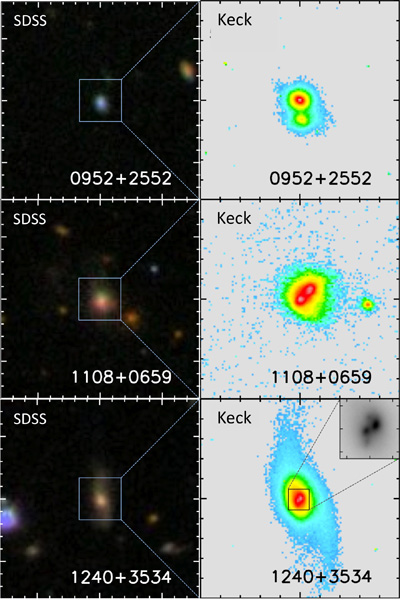Seattle, WA – Astronomers at the California Institute of Technology (Caltech), University of Illinois at Urbana-Champaign (UIUC), and University of Hawai’i (UH) have discovered 16 close-knit pairs of supermassive black holes in merging galaxies. The research findings, based on observations done at the W. M. Keck Observatory on Mauna Kea, were presented in Seattle this week at the 217th meeting of the American Astronomical Society.The black-hole pairs, also called binaries, are about a hundred to a thousand times closer together than most that have been observed before, providing astronomers a glimpse into how these behemoths and their host galaxies merge—a crucial part of understanding the evolution of the universe. Although few similarly close pairs have been seen previously, this is the largest population of such objects observed as the result of a systematic search.
“This is a very nice confirmation of theoretical predictions,” says S. George Djorgovski, Professor of Astronomy at Caltech. “These close pairs are a missing link between the wide binary systems seen previously and the merging black-hole pairs at even smaller separations that we believe must be there.”
As the universe has evolved, galaxies have collided and merged to form larger ones. Nearly every one—or perhaps all—of these large galaxies contains a giant black hole at its center, with a mass millions—or even billions—of times higher than the sun’s. Material such as interstellar gas falls into the black hole, producing enough energy to outshine galaxies composed of a hundred billion stars. The hot gas and black hole form an active galactic nucleus, the brightest and most distant of which are called quasars. The prodigious energy output of active galactic nuclei can affect the evolution of galaxies themselves.
While galaxies merge, so should their central black holes, producing an even more massive black hole in the nucleus of the resulting galaxy. Such collisions are expected to generate bursts of gravitational waves, which have yet to be detected. Some merging galaxies should contain pairs of active nuclei, indicating the presence of supermassive black holes on their way to coalescing. Until now, astronomers have generally observed only widely separated pairs—binary quasars—which are typically hundreds of thousands of light-years apart.
“If our understanding of structure formation in the universe is correct, closer pairs of active nuclei must exist,” adds Adam Myers, a research scientist at UIUC and one of the coauthors of the research that has been submitted for publication in the Astrophysical Journal. “However, they would be hard to discern in typical images blurred by Earth’s atmosphere.”
The solution was to use Laser Guide Star Adaptive Optics, a technique that enables astronomers to remove the atmospheric blur and capture images as sharp as those taken from space. One such system is deployed on the W. M. Keck Observatory’s 10-meter telescopes on Mauna Kea.
The W. M. Keck Observatory operates two 10-meter optical/infrared telescopes on the summit of Mauna Kea. The Observatory is a private 501(c) 3 organization and a scientific partnership of the California Institute of Technology, the University of California and NASA.


